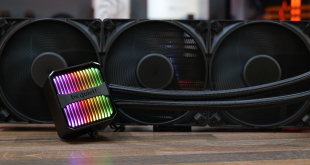The Gigabyte G1.Sniper Z87 is a good-looking motherboard that offers solid overclocking performance, a host of worthwhile gaming features, and a number of audiophile-level adaptations.
We had no problems taking our 4770K to its 4.5GHz limit with the G1.Sniper Z87. The process was as simple as applying the correct voltage tweaks and selecting the 45x core ratio. Gigabyte's board didn't complain or mess around with our UEFI inputs, it simply booted up at 4.5GHz and worked with perfect stability.
General performance of the G1.Sniper Z87 was as good as we would expect from a typical Z87 motherboard. USB 3.0 performance was lacking in comparison to ASRock and Asus' UASP-activating options, but Gigabyte's board did provide similar numbers to MSI's Z87M Gaming. Whether or not the lower USB 3.0 throughput numbers will displease gamers is a question that is open for debate.
Gamers are likely to be pleased by the Killer E2201 NIC's ability to control network prioritisations. The software-assisted control will help gamers receive sufficient low-latency network bandwidth to prevent their games lagging.
For audio enthusiasts, Gigabyte's G1.Sniper Z87 offers an extensive array of sound-related adaptations. Creative's Sound Core 3D quad core audio processor delivers impressive performance when backed by its arsenal of TI OPA2134 OP-AMP, high-end Nichicon audio capacitors, and the interference-reducing isolated signal path. Gold-plated connectors act as further prevention to the loss of quality from an audio signal.
Layout of the motherboard in general is very good. Our biggest concern is the fan header distribution. Gigabyte only provides a single CPU fan header which leaves a CPU cooler's secondary fan and a unit mounted to the rear of a case fighting for the one header near their locations.
Both of the remaining headers are located on the board's bottom-edge which will force a fan cable to be routed across a motherboard and graphics card in many circumstances. This has a negative effect on the appearance of a system's cable management. Omitting the widely-used secondary CPU fan header was a bad decision on Gigabyte's part.
Gigabyte's high-resolution UEFI BIOS features excellent styling and is filled with useful information and adjustable parameters. The interface certainly takes some practise to use effectively, though. The sheer number of options displayed on-screen at any one time is daunting for novice overclockers.
Automated overclocking options provided by the G1.Sniper Z87 were poorly implemented. Many of the profiles used voltages levels which would be considered unusable for users without custom watercooling loops. The one well-programmed ‘Performance Boost' profile used a CPU speed above the limit that many Haswell chips are capable of reaching. Luckily, the G1.Sniper Z87's target audience is likely to be able to overlook shortfalls of the automated overclocking profiles.
Retailing at less than £120, and currently available for £113.99 from OverclockersUK, the Gigabyte G1.Sniper Z87 offers excellent value for money. Both MSI and ASRock provide competition in this segment, but Gigabyte's extensive set of audio-related upgrades and unique design make the G1.Sniper Z87 a motherboard which is certainly worth purchasing.
Pros:
- Extensive audio-related upgrades, many audiophile-grade.
- Competitively priced.
- Solid overclocking capabilities.
- Attractive and unique colour scheme.
- Good gaming features – Killer LAN and audio tweaks.
- Onboard buttons.
Cons:
- Questionable fan header distribution and only one CPU connection.
- Novice users may struggle to navigate and understand the UEFI's layout.
- Bad auto OC profiles.
KitGuru says: Filled with worthwhile gaming features and offering fine performance with good overclocking results, Gigabyte's G1.Sniper Z87 is a potent motherboard which tempts gamers with its attractive price tag and eye-catching design.
 KitGuru KitGuru.net – Tech News | Hardware News | Hardware Reviews | IOS | Mobile | Gaming | Graphics Cards
KitGuru KitGuru.net – Tech News | Hardware News | Hardware Reviews | IOS | Mobile | Gaming | Graphics Cards




Just ordered it from OCUK – using it for a new build in the new year. good price.
nice colour scheme, nothing I have would match it, so would be quite a change over from my asus board. Gigabyte boards t his year look the best though, no doubt about it.
Its about time these companies put more effort into the onboard audio, so good move gb.
I always really like how they put power and reset switches up close to the memory, they are a godsend when testing things.
I bought this board and its been great – rock solid at 4.4ghz, as I dont like pushing my CPU too high – they run hot. not like ivybridge.
Very well written review, looks like a winner for its price point.
Is anybody intending to buy this board in hope of connecting it to a non galvanic usb dac in order to minimize noise transfer?
Of all the reviews I’ve seen so far, I’ve not seen one that goes into depth regarding the usb dac-up feature yet seem to be concentrating on the performance of onboard sound only.
Hi guys, between this Gigabyte and the Asus Hero, which one is better choice for a gaming rig?